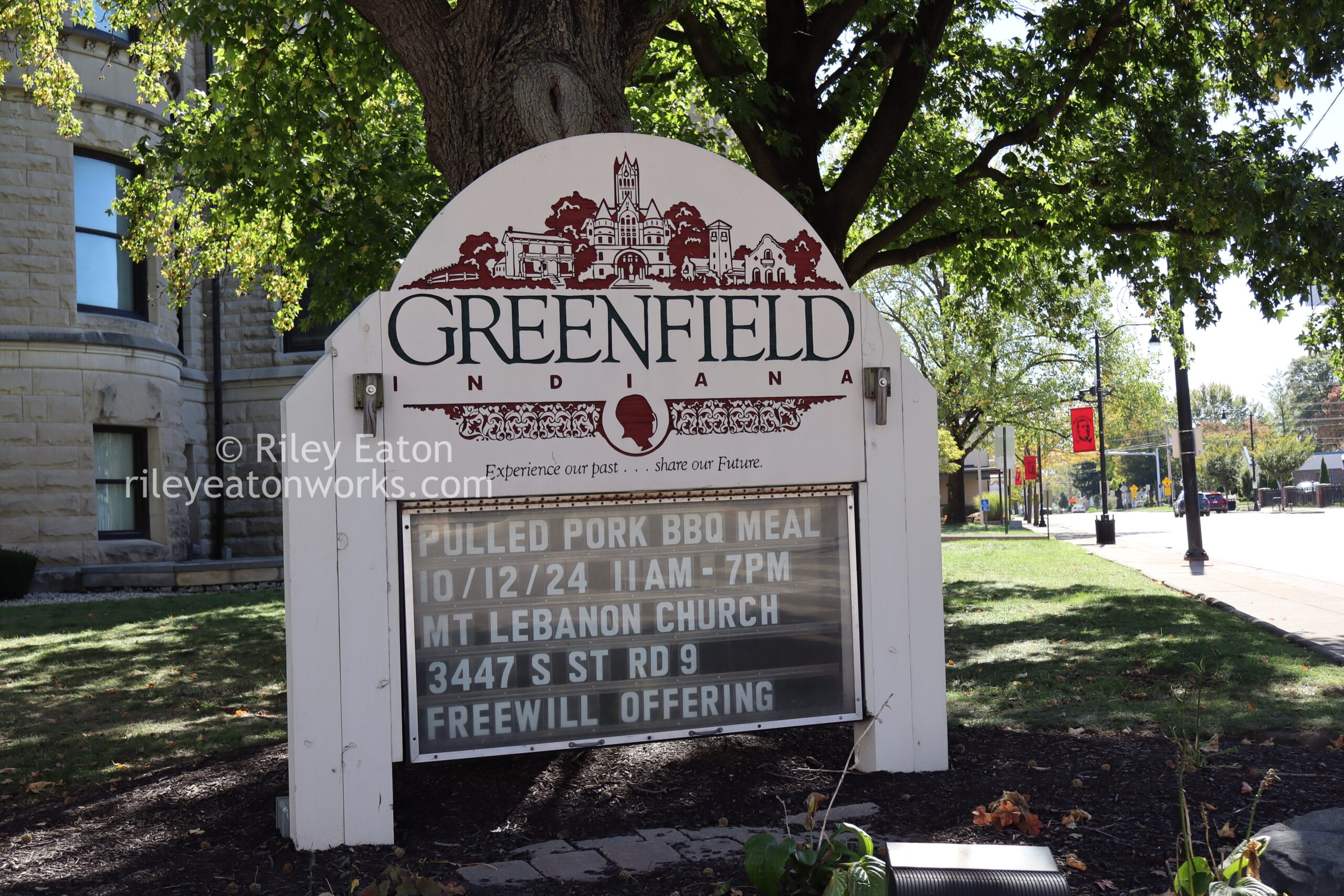Indiana holds a plethora of historic places. Maybe it’s an obvious statement—where in the world is there not historic places? But even as someone who was raised in Indiana, when I think of it from an outsider’s perspective, I just think of cornfields—what else is there?
The answer: Greenfield.
Well, there’s more than Greenfield that makes Indiana interesting, but Greenfield is truly a hidden gem in the shadow of sprawling Indianapolis. Old brick walls, busy roads, the smell of french fries drifting from restaurants, lush greenery, and plenty of industrial vehicles casually rolling down the road—there’s a scenic yet bustling feel to Greenfield, and it’s lovely.
In October of 2024, I had the opportunity to tour a good chunk of downtown Greenfield with someone who knows around the town. The main goal of the tour was to get architectural photos, but I thought I’d share the photos I got that day and share some history about each location!
So, let’s get to it!
The Depot
I met up with the other person I was going to walk with after noon, at a resturant called The Depot.
The Depot is a local resturant that’s been open for a few years1. It’s not on downtown Greenfield’s main street, but it is located on a block whose street is directly connected to Main Street—so not far from the main strip.
I was also told that the resturant holds free live music shows in the summer for the community!
The Depot is a mainly brick building with two monolithic towers attached to the main floor. It is clearly old by the build style and build materials. I learned through The Depot’s website that the building was originally a grain elevator, built in 1906 and operated and owned by the Hancock County Farm Bureau Co-Op from 1931 to 19941.
The grain elevator was used to store and buy wheat, with a whopping storage capacity of 40,000 grain bushels1.
The Pennsylvania Railroad made its way to Greenfield through a double-tracking system in 1945, prompting the need for an additional unloading site at the grain elevator, plus other renovations with the thought of future rail updates1. The renovations took two years, resulting in a basement level, a 50 ton scale, the first level of elevator, and 112-foot tall towers1.
Reportedly, some WWII veterans who had returned from the war worked on the elevator throughout its renovation period1.



In 1994, the building was privately sold to a Greenfield farmer, then the building’s operations stopped around 20031. The property went vacant and unused until a group of Greenfield business owners known as the Depot Street Investments purchased the property from the City of Greenfield in 2020 to prevent the building’s demolition over structural integrity concerns1. The Depot’s website does not clarify when or how the building came into possession of the City of Greenfield prior to the Depot Street Investments sale. However, the investor group’s reason for purchasing the building was its historic significance and their own fond childhood memories of the building and its property—they saved a nostalgic site for the older locals and repurposed it into a resturant for future locals1.
While I didn’t eat at The Depot that day, I was impressed by its outward preservation. I also noticed what must have been a remaining Pennsylvania Railroad line permanently embedded (though not in use) in the sidewalk in The Depot’s yard & outdoor seating area. I walked on the rails to approach the building for a photo op, unaware at the time of its history or how it shaped the building’s development.
Fun bonus: next to The Depot is a small strip of street made entirely of brick—I’m betting it’s one of the original city roads before asphalt was introduced!

The First Presbyterian Church
Not too far North from The Depot is the First Presbyterian Church. It’s a beautiful building, featuring a small tower with crenellation and stained glass windows.
I couldn’t find any information online about the church’s history, but the architecture alone indicates an old build date.
It looks like, perhaps, the building has a limestone foundation?


Bradley United Methodist Church
Across the street from the Presbyterian church is the Bradley United Methodist Church.
It’s a beautiful building, but I never would’ve guessed that the congregation is as old as it is! The church was organized in the same year that Greenfield was established as the county seat of Hancock County (1828), and among organizing members of Methodist settlers was James Whitcomb Riley’s grandmother, Margaret Riley2.
Who is James Whitcomb Riley?
More about him later!
This UMC originally met for service in rotating locations, including a school house, several private homes, and the county courthouse2. Eventually, the congregation got a dedicated church building—a frame structure—in 1841, then they changed to a brick building in 1867, then finally a larger building in 19022. The 1902 building is Bradley UMC’s current home, pictured below2. I wonder if the First Presbyterian Church was originally the Bradley United Methodist Church’s 1867 brick building?
Bradley UMC includes the name “Bradley” because in the early 1900s, the at-the-time president of the Greenfield Banking Company, Nelson Bradley, was one of the church’s biggest benefactors2.


E Main Street and James Whitcomb Riley
Heading East down E Main Street, there is the main strip of likely-original buildings lining the street that still house businesses to this day. Among the present businesses are the HJ Ricks Center For The Arts, the Lincoln Square Pancake House, Tiffany’s Salon and Spa, the J.W. Riley Emporium, Griggsby’s Station, and more!


Now there’s that name Riley again: J.W. Riley Emporium. Who are the Rileys to Greenfield? After all, “Riley” or “James Whitcomb Riley” repeats itself throughout the town in street names, murals, business names, and even banners hanging on the streetlights.

James Whitcomb Riley was a creative man who is treated like a hero. Nicknamed the Hoosier Poet, this Greenfield local became a successful poet in the late 1800s, known for such books as Out to Old Aunt Mary’s, The Old-Swimmin’ Hole and ‘Leven More Poems, Riley Child-Rhymes, and An Old Sweetheart3.
Most notably, James Whitcomb Riley was the originator of Little Orphan Annie! Known for her distinctive curly red hair, determined attitude, and iconic musical number “It’s A Hard Knock Life”, Annie was first introduced to the world through Riley’s poem Little Orphant Annie, which never explicitly describes this character’s appearance but does paint a picture of her life as a helping hand to a family, and the spooky tales she told the family’s little boys about goblins kidnapping kids who misbehave4!
Riley, his artistic heritage, and his birthday are celebrated annually through the town’s Riley Festival. Often referred to by locals as “Riley Days”, the festival takes place on the streets surrounding the county courthouse, starting on the first Thursday of October and running until Saturday evening5.
Each year’s Riley Festival is themed to a poem written by Riley, and the three fun-filled days include local craft vendors, flea market booths, plenty of good food, art and prose contests, pageants, a Parade of Flowers, a Saturday parade, and much more5!

A final thing of note is Riley’s actual childhood home is in Greenfield, on the downtown’s Western outskirt! Riley’s childhood home is currently a museum called The James Whitcomb Riley Boyhood Home. The museum offers tours of the 19th century home, where people can learn about the Hoosier poet’s early life, facets of his life that inspired some of his poems, and what day-to-day life looked like for 19th century families.
Unfortunately, my camera battery died before I could get any photos of the Boyhood Home’s exterior. Perhaps I should come back to Greenfield someday to tour the museum?
The Circuit Court
Not far from the J.W. Riley Emporium is the Hancock County Circuit Court. Stunningly crafted, the brick building stands in the heart of Greenfield.
At the top of every hour, a bell rings out from the looming bell tower, brief but crisp.


The courthouse in features a lush lawn and Romanesque Revival architecture6.

If I had to guess, the building is made primarily out of limestone—Indiana is known for its limestone, a material that gained popularity with early pioneers in Indiana, and again with Hoosier builders in the late 1800s7.
And let’s not forget that Indiana limestone represented 80% of the U.S.’s limestone output by 1920… and the Empire State Building and the Pentagon are built out of Indiana limestone…7
Okay, I’ll stop flexing about Indiana limestone.

Prior to its existence, the site of the current courthouse originally held a pond, with a log jail to the east (built circa 1828) and a two-story log courthouse to the west (built circa 1829)8.
The pond was drained and filled, then a brick courthouse constructed on the site in 1834 when the National Road opened8.
In 18986, a new courthouse was completed on the site in place of the brick courthouse—a two-story building with a bell tower8. The two-story courthouse is the one that stands to this day.


To Be Continued
There’s so much to unpack from my trip that I didn’t want to put it all in one article—it’d be too long all together! So, a part two is coming soon.
Stay tuned!
References
1 The Depot. “Our History.” The Depot,
https://thedepot1906.com/about-us/
Accessed 22 February 2025.
2 Bradley UMC. “About Bradley United Methodist Church.” Bradley United Methodist Church,
https://bradleyumc.org/about/#history
Accessed 22 February 2025.
3 Poetry Foundation. “James Whitcomb Riley.” Poetry Foundation,
https://www.poetryfoundation.org/poets/james-whitcomb-riley
Accessed 22 February 2025.
4 Riley, James Whitcomb. “Little Orphant Annie.” Poets.org,
https://poets.org/poem/little-orphant-annie
Accessed 22 February 2025.
5 Riley Festival. “About The Riley Festival.” Riley Festival,
https://rileyfestival.com/
Accessed 22 February 2025.
6 Deer, Kristy. “Signatures as far back as late 1800s cover fourth floor of county courthouse.” Daily Reporter.
https://www.greenfieldreporter.com/2023/07/21/signatures-as-far-back-as-late-1800s-cover-fourth-floor-of-county-courthouse/
Accessed 22 February 2025.
7 “Indiana Limestone: A History.” YouTube, uploaded by Journey Indiana, 23 March 2017,
https://www.youtube.com/watch?v=RSejxl80CwU
Accessed 22 February 2025.
8 National Register of Historic Places.
https://npgallery.nps.gov/GetAsset/04728001-c8b4-4a4c-a699-3ac3c10c6b24
Accessed 22 February 2025.





Leave a Reply